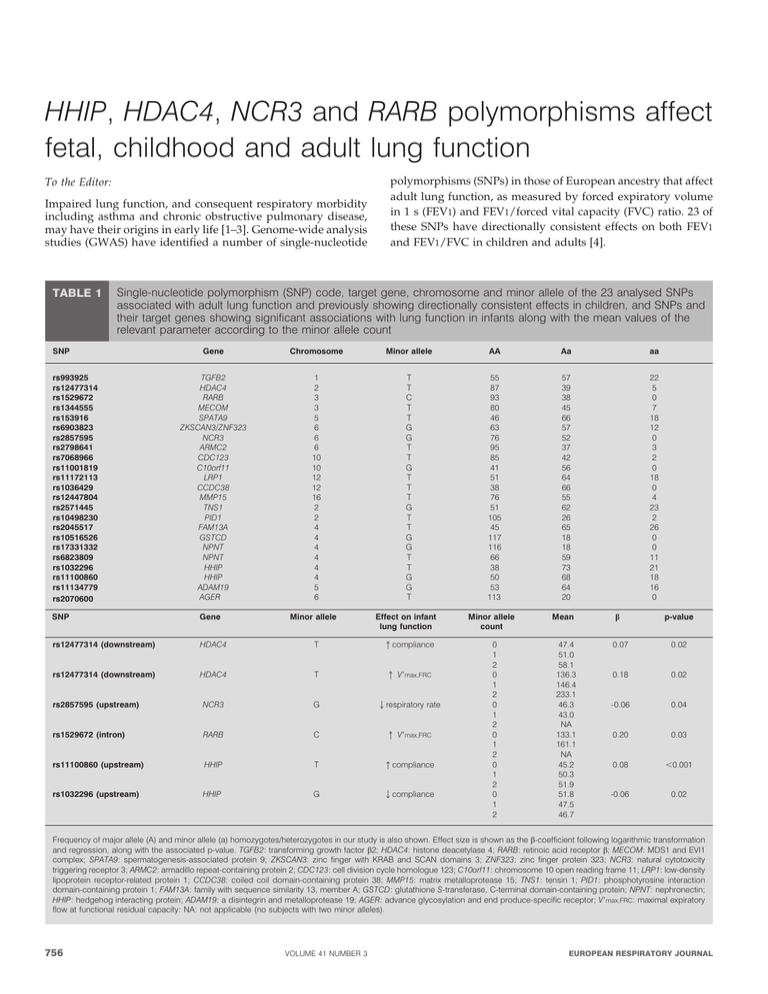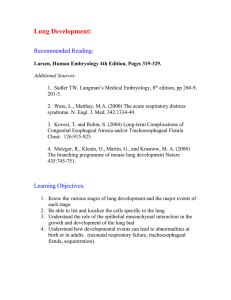HHIP, HDAC4, NCR3 and RARB polymorphisms affect fetal
advertisement

HHIP, HDAC4, NCR3 and RARB polymorphisms affect fetal, childhood and adult lung function To the Editor: Impaired lung function, and consequent respiratory morbidity including asthma and chronic obstructive pulmonary disease, may have their origins in early life [1–3]. Genome-wide analysis studies (GWAS) have identified a number of single-nucleotide TABLE 1 polymorphisms (SNPs) in those of European ancestry that affect adult lung function, as measured by forced expiratory volume in 1 s (FEV1) and FEV1/forced vital capacity (FVC) ratio. 23 of these SNPs have directionally consistent effects on both FEV1 and FEV1/FVC in children and adults [4]. Single-nucleotide polymorphism (SNP) code, target gene, chromosome and minor allele of the 23 analysed SNPs associated with adult lung function and previously showing directionally consistent effects in children, and SNPs and their target genes showing significant associations with lung function in infants along with the mean values of the relevant parameter according to the minor allele count SNP rs993925 rs12477314 rs1529672 rs1344555 rs153916 rs6903823 rs2857595 rs2798641 rs7068966 rs11001819 rs11172113 rs1036429 rs12447804 rs2571445 rs10498230 rs2045517 rs10516526 rs17331332 rs6823809 rs1032296 rs11100860 rs11134779 rs2070600 Gene Chromosome Minor allele AA Aa aa TGFB2 HDAC4 RARB MECOM SPATA9 ZKSCAN3/ZNF323 NCR3 ARMC2 CDC123 C10orf11 LRP1 CCDC38 MMP15 TNS1 PID1 FAM13A GSTCD NPNT NPNT HHIP HHIP ADAM19 AGER 1 2 3 3 5 6 6 6 10 10 12 12 16 2 2 4 4 4 4 4 4 5 6 T T C T T G G T T G T T T G T T G G T T G G T 55 87 93 80 46 63 76 95 85 41 51 38 76 51 105 45 117 116 66 38 50 53 113 57 39 38 45 66 57 52 37 42 56 64 66 55 62 26 65 18 18 59 73 68 64 20 22 5 0 7 18 12 0 3 2 0 18 0 4 23 2 26 0 0 11 21 18 16 0 SNP Gene Minor allele Effect on infant lung function rs12477314 (downstream) HDAC4 T qcompliance rs12477314 (downstream) HDAC4 T q V9max,FRC rs2857595 (upstream) NCR3 G Qrespiratory rate rs1529672 (intron) RARB C q V9max,FRC rs11100860 (upstream) HHIP T qcompliance rs1032296 (upstream) HHIP G Qcompliance Minor allele count 0 1 2 0 1 2 0 1 2 0 1 2 0 1 2 0 1 2 Mean 47.4 51.0 58.1 136.3 146.4 233.1 46.3 43.0 NA 133.1 161.1 NA 45.2 50.3 51.9 51.8 47.5 46.7 b p-value 0.07 0.02 0.18 0.02 -0.06 0.04 0.20 0.03 0.08 ,0.001 -0.06 0.02 Frequency of major allele (A) and minor allele (a) homozygotes/heterozygotes in our study is also shown. Effect size is shown as the b-coefficient following logarithmic transformation and regression, along with the associated p-value. TGFB2: transforming growth factor b2; HDAC4: histone deacetylase 4; RARB: retinoic acid receptor b; MECOM: MDS1 and EVI1 complex; SPATA9: spermatogenesis-associated protein 9; ZKSCAN3: zinc finger with KRAB and SCAN domains 3; ZNF323: zinc finger protein 323; NCR3: natural cytotoxicity triggering receptor 3; ARMC2: armadillo repeat-containing protein 2; CDC123: cell division cycle homologue 123; C10orf11: chromosome 10 open reading frame 11; LRP1: low-density lipoprotein receptor-related protein 1; CCDC38: coiled coil domain-containing protein 38; MMP15: matrix metalloprotease 15; TNS1: tensin 1; PID1: phosphotyrosine interaction domain-containing protein 1; FAM13A: family with sequence similarity 13, member A; GSTCD: glutathione S-transferase, C-terminal domain-containing protein; NPNT: nephronectin; HHIP: hedgehog interacting protein; ADAM19: a disintegrin and metalloprotease 19; AGER: advance glycosylation and end produce-specific receptor; V9max,FRC: maximal expiratory flow at functional residual capacity: NA: not applicable (no subjects with two minor alleles). 756 VOLUME 41 NUMBER 3 EUROPEAN RESPIRATORY JOURNAL During 1998–2002, the Southampton Women’s Survey recruited 12,579 females pre-conception through their general practitioners [5]. By the end of 2003, there had been 1,973 babies born to these females, of which 147 had infant lung function measured between 5 and 14 weeks of age, according to previously published protocols [6] using raised volume/rapid compression techniques to measure maximal expiratory flow at functional residual capacity (V9max,FRC), FEV0.4, respiratory rate and compliance. DNA was obtained from cord blood samples or from buccal samples taken at the 6-yr follow-up. DNA from these 147 children was analysed for each of the 23 SNPs identified as above. These SNPs are detailed in table 1. Linear regression was used to analyse the minor allele count for each SNP (either 0, 1 or 2) against logarithmically transformed and age-adjusted values for infant lung compliance, respiratory rate, FEV0.4 and V9max,FRC. Smoking in pregnancy, maternal body mass index, social class, birth weight, gestation and crown–rump length were analysed as potential confounding factors. The average n per group (0, 1 or 2 minor alleles) across all 23 SNPs was 71, 50 and 9, respectively, giving 80% power to detect a 3.7-mL?mmH2O-1 change in compliance per increase in minor allele count. Five SNPs, relating to four genes, showed significant associations with infant lung function (table 1). Hedgehog interacting protein (HHIP) had one SNP (rs11100860) that was associated with increased compliance (p,0.001) and one (rs1032296) associated with decreased compliance (p,0.05). Retinoic acid receptor b (RARB) (rs1529672) was associated with increased V9max,FRC (p,0.05), the natural cytotoxicity triggering receptor 3 (NCR3) SNP (rs2857595) was associated with a lower respiratory rate (p,0.05), and the histone deacetylase 4 (HDAC4) SNP (rs12477314) was associated with both increased compliance and V9max,FRC (both p,0.05). Table 1 summarises these findings. These effects were all directionally consistent with the previous GWAS. HHIP is known to have a role in lung development through fibroblast growth factor 10 (FGF10) and its control of lung branching [7], while RARB regulates lung bud formation and branching through the Wnt pathway [8] with retinoic acid playing a central role in pre- and post-natal lung development in humans [9]. HDAC4 and NCR3 have uncertain roles in lung development, though the former may modulate epigenetic effects on lung function. Branching of the lung occurs in the pseudoglandular phase and is complete by 16 weeks of gestation [10]; therefore, RARB and HHIP are likely to have their effects in the first trimester. Early branching is the primary determinant of resistance in normal lungs and, therefore, of compliance. This large airway function is reflected as FEV1 and FEV1/FVC in later life; thus, there is a scientifically plausible link between these SNPs and lung function. As there was a priori evidence of association between these SNPs and lung function, we have not corrected for the number of SNPs and lung function tests. However, even if a Bonferroni correction is applied (23 SNPs 6 4 lung function measurements), the rs11100860 HHIP SNP remains significant. As the original GWAS was in similar populations to our cohort, we feel it reasonable to assume the key SNPs identified may be good proxy markers of the causal locus. It is also possible that the present study was underpowered to detect significant associations between infant lung function and the other SNPs tested. EUROPEAN RESPIRATORY JOURNAL We accept that small numbers and multiple testing are limitations of our study; however, these results may link early fetal lung development, through infant lung function, to adult lung function and respiratory morbidity in later life. This is an interesting starting point for identification of the mechanisms of fetal origins of lung function. Samuel A. Collins*,#, Jane S.A. Lucas*,#, Hazel M. Inskip",+, Keith M. Godfrey",+,1, Graham Roberts*,#,", John W. Holloway*," and the Southampton Women’s Survey Study Group+ *Clinical and Experimental Sciences Academic Unit, University of Southampton Faculty of Medicine, "Human Development and Health Academic Unit, University of Southampton Faculty of Medicine, #NIHR Southampton Respiratory Biomedical Research Unit, University of Southampton and University Hospital Southampton NHS Foundation Trust, 1NIHR Southampton Biomedical Research Centre, University of Southampton and University Hospital Southampton NHS Foundation Trust, and + Southampton Medical Research Council Lifecourse Epidemiology Unit, University of Southampton, Southampton, UK. Correspondence: S.A. Collins, Human Genetics and Medical Genomics, University of Southampton Faculty of Medicine, Duthie Building, MP808, Southampton General Hospital, Southampton, SO16 6YD, UK. E-mail: samacollins@gmail.com Statement of Interest: A statement of interest for K.M. Godfrey can be found at www.erj.ersjournals.com/site/misc/statements.xhtml REFERENCES 1 Håland G, Carlsen KCL, Sandvik L, et al. Reduced lung function at birth and the risk of asthma at 10 years of age. N Engl J Med 2006; 355: 1682–1869. 2 Stern DA, Morgan WJ, Wright AL, et al. Poor airway function in early infancy and lung function by age 22 years: a non-selective longitudinal cohort study. Lancet 2007; 370: 758–764. 3 Krauss-Etschmann S, Bush A, Bellusci S, et al. Of flies, mice and men: a systematic approach to understanding the early life origins of chronic lung disease. Thorax 2012 [in press DOI: 10.1136/ thoraxjnl-2012-201902]. 4 Artigas MS, Loth DW, Wain LV, et al. Genome-wide association and large-scale follow up identifies 16 new loci influencing lung function. Nat Genet 2011; 43: 1082–1090. 5 Inskip HM, Godfrey KM, Robinson SM, et al. Cohort profile: the Southampton Women’s Survey. Int J Epidemiol 2006; 35: 42–48. 6 Lucas JS, Inskip HM, Godfrey KM, et al. Small size at birth and greater postnatal weight gain: relationships to diminished infant lung function. Am J Respir Crit Care Med 2004; 170: 534–540. 7 Warburton D, Bellusci S, Del Moral PM, et al. Growth factor signaling in lung morphogenetic centers: automaticity, stereotypy and symmetry. Respir Res 2003; 4: 5. 8 Kam RKT, Deng Y, Chen Y, et al. Retinoic acid synthesis and functions in early embryonic development. Cell Biosci 2012; 2: 11. 9 Biesalski HK, Nohr D. Importance of vitamin-A for lung function and development. Mol Aspects Med 2003; 24: 431–440. 10 Kitaoka H, Burri PH, Weibel ER. Development of the human fetal airway tree: analysis of the numerical density of airway endtips. Anat Rec 1996; 244: 207–213. DOI: 10.1183/09031936.00171712 VOLUME 41 NUMBER 3 757 c







